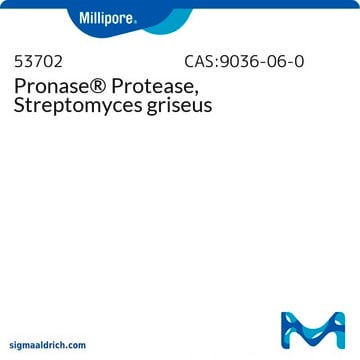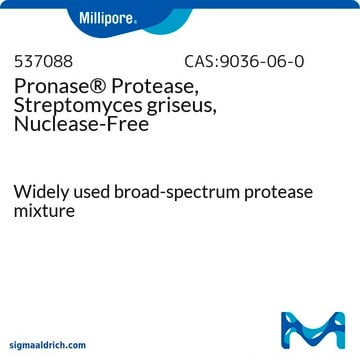P5147
Protease from Streptomyces griseus
Type XIV, ≥3.5 units/mg solid, powder
Synonim(y):
Actinase E, Pronase E
About This Item
Polecane produkty
pochodzenie biologiczne
Streptomyces griseus
Poziom jakości
typ
Type XIV
Postać
powder
aktywność właściwa
≥3.5 units/mg solid
rozpuszczalność
10 mM NaAc (pH 7.5) and 5 mM CaAc: soluble 0.2 mg/mL at 37 °C, clear, colorless to tan
Warunki transportu
wet ice
temp. przechowywania
−20°C
Szukasz podobnych produktów? Odwiedź Przewodnik dotyczący porównywania produktów
Powiązane kategorie
Specyficzność
Zastosowanie
- for the digestion of nucleus pulposus (NP) tissue
- in the catalysis of asymmetric one pot Mannich reaction
- for deproteinization of starch
- digestion of brain slices for the cell dissociation
Działania biochem./fizjol.
Cechy i korzyści
- highly stable in pH range of 5.0 to 9.0, with peak activity at pH 8.8
- compatible with many DNA and RNA isolation buffers
- broad substrate specificity
Jakość
Właściwości fizyczne
Definicja jednostki
Uwaga dotycząca przygotowania
produkt powiązany
Hasło ostrzegawcze
Danger
Zwroty wskazujące rodzaj zagrożenia
Zwroty wskazujące środki ostrożności
Klasyfikacja zagrożeń
Eye Irrit. 2 - Resp. Sens. 1 - Skin Irrit. 2 - STOT SE 3
Organy docelowe
Respiratory system
Kod klasy składowania
11 - Combustible Solids
Klasa zagrożenia wodnego (WGK)
WGK 2
Temperatura zapłonu (°F)
Not applicable
Temperatura zapłonu (°C)
Not applicable
Środki ochrony indywidualnej
Eyeshields, Gloves, type N95 (US)
Certyfikaty analizy (CoA)
Poszukaj Certyfikaty analizy (CoA), wpisując numer partii/serii produktów. Numery serii i partii można znaleźć na etykiecie produktu po słowach „seria” lub „partia”.
Masz już ten produkt?
Dokumenty związane z niedawno zakupionymi produktami zostały zamieszczone w Bibliotece dokumentów.
Klienci oglądali również te produkty
Nasz zespół naukowców ma doświadczenie we wszystkich obszarach badań, w tym w naukach przyrodniczych, materiałoznawstwie, syntezie chemicznej, chromatografii, analityce i wielu innych dziedzinach.
Skontaktuj się z zespołem ds. pomocy technicznej













